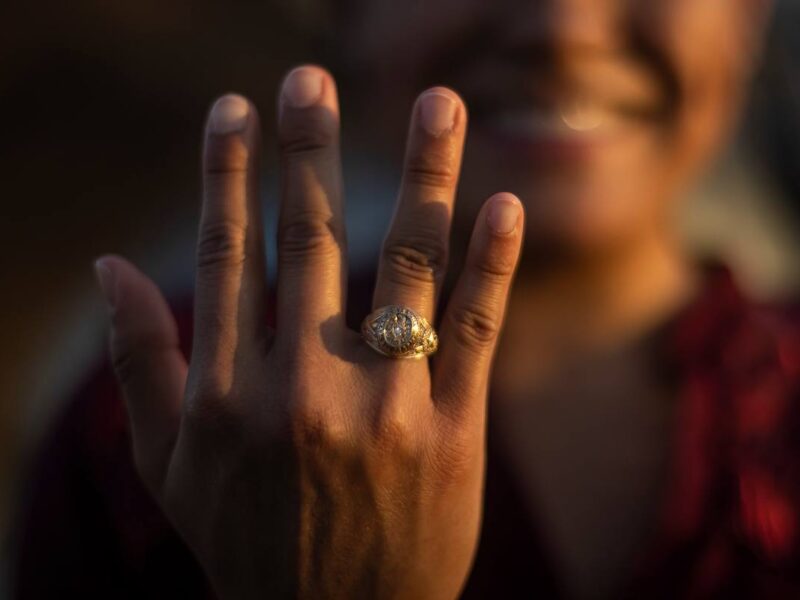The Strength Of The Aggie Ring
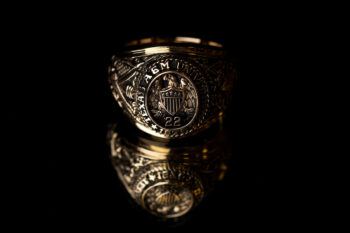
Decades of stories tell of Texas Aggies greeting each other on sight, all over the world, no matter if they are wearing business attire or a uniform or tourist gear.
This is possible because of the extraordinary strength of the Aggie Ring. The Aggie Ring Program, with roots going back to 1889 and operated by The Association of Former Students since 1969, is the largest college ring program in the country, unique in its scope, history and enthusiastic adoption.
Each year, over 15,000 Texas A&M students complete the requirements and order their Aggie Rings – the purchase rate is 94% among undergraduates who qualify. Traditionally, they wear their Aggie Rings throughout their lives, carrying the most visible symbol of the Aggie Network out across the globe. Though college rings began at West Point and remain strong with military academies, Texas A&M’s Aggie Ring survived the transition from military-only to a large public university population.
Today, Texas A&M’s program is larger than any other college ring account with America’s three biggest manufacturers, Balfour, Jostens and Herff-Jones, company representatives said. That most likely makes Texas A&M’s the largest college ring program in the world, since school rings originated in the U.S. and are “a much bigger phenomenon here than in other countries,” said Balfour representative Lee Briggs ’94.
Balfour has manufactured all Aggie Rings since 1947, and the Aggie Ring Program is more than triple the size of Balfour’s next-largest college ring accounts. Balfour has around 55% of the college ring market, including 75% of the colleges that have an established college ring program, Briggs said. Their second largest college account is Clemson University, with around 4,500 rings per year; third is the University of Texas at around 2,500 rings per year, Briggs said.
How does the Aggie Ring thrive, even as ring programs at other schools work to catch up?
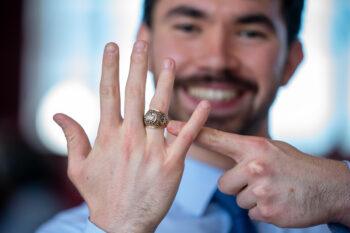
High Standards
Strict qualifications mean each Aggie Ring represents the wearer’s hard work and academic achievement.
Aggie Ring qualifications are among the tightest in the country – and they’ve been in place since the 1930s, with periodic updates.
Back in 1933, officers of the Class of ’31 petitioned the A&M faculty to restrict purchase of the Aggie Ring to students who have attained at least the second semester of their junior year.
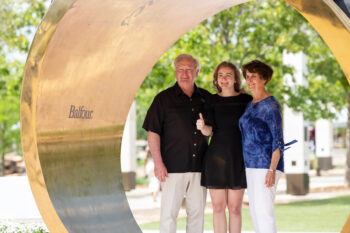
Today, Aggie Ring requirements for undergraduates include 90 completed credit hours, with 45 at Texas A&M; a cumulative GPR of 2.0 or higher; and good academic standing. Qualifications for grad students and former students are similar.
These standards are inflexible; exceptions are not made, and each individual may only order a single Aggie Ring. The Association conducts audits to ensure each recipient is qualified.
“There has always been a very real mystique surrounding the Aggie Ring. And an unbelievable amount of pride in earning one,” said Class Agent Robert Oliver ’74 (Class Agents are Association volunteers who work to connect Classmates to each other and Texas A&M).
That pride is on full display both when students order their Aggie Rings – many take photos commemorating the moment – and at Aggie Ring Days, when students invite 40,000 family members and friends to see them pick up their bands of gold.
Although strict ring requirements once were uncommon at other schools, Briggs said that in the past 20 years, the college ring market is shifting toward Texas A&M’s model with “all of the elements that A&M has had for years”: tight criteria, a single ring design and specific delivery days with a celebratory event. Texas A&M’s first event celebrating the Aggie Ring began in 1934: Ring Dance has provided generations of Aggie photos under a giant replica Aggie Ring. Today, Ring Dance is put on by the student Class Councils, and the 2024 Ring Dance will be hosted on April 26 by The Association, which has long provided support for both Class Councils and Ring Dance.
Briggs believes the visibility of the Aggie Ring and pride in earning one have been elevated by two recent Association additions to the tradition: Aggie Ring Day, which began in 2000, and the three-ton Haynes Ring monument, dedicated in 2009.
“I think when you attend a Ring Day and you see the students bring their parents and grandparents, it’s something that you feel like as an Aggie you need to participate in,” Briggs said. Upon its unveiling, the Haynes Ring Plaza instantly became a campus landmark and the focal point for thousands of celebratory Aggie photographs.
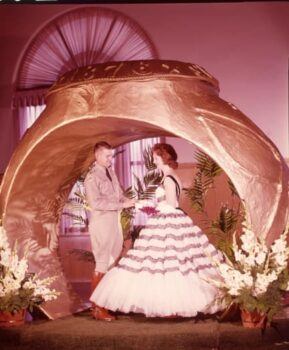
“I don’t think anybody really knew how big a symbol that would be,” Briggs said. “Those maintained and increased the importance of Aggies wanting to get their Aggie Rings.”
Association President and CEO Porter Garner ’79, who had the idea to create Aggie Ring Day and has overseen its development as well as the creation of the Haynes Ring, said it’s hard to estimate their effect accurately, but “intuitively, you would be hard-pressed not to believe that it has to impact the anticipation.”
Garner noted that Aggie Ring Day also helps others learn: “Starting in 2000, you had parents who never went here, grandparents who never went here, you had faculty members come over. And you look at it today: There are thousands of people that know more about the Aggie Ring than ever because we’ve included them in Aggie Ring Day.” Ultimately, Garner said, “I think it is our graduates, the people who wear the Aggie Ring, who have made the Ring strong.
“I think it means more today than it ever has. Because I think Aggies look for the Aggie Ring – they look to connect – and it means you can trust whoever that person is. Because you have a bond with them.”
Historic Design
The symbolism of the Aggie Ring began in the 1880s, has been standardized since 1933 and carries great meaning.
“Consistency of design,” said Class Agent Philip Leopold ’84, makes the Aggie Ring “easy to spot in a crowd of rings. Many schools have made the mistake of allowing custom-tailored rings.”
Balfour representative Briggs agreed: “When I started 30 years ago, most colleges or universities had several different ring designs you could choose from, and several different manufacturers. There was a multitude of different designs, and A&M stood alone because of having one single design.”
More schools now are moving toward a single approved ring style, Briggs said. But they are starting from nearly a century behind. Since 1933, the Aggie Ring has had a distinctive design, recognizable worldwide.
The earliest rings at Texas A&M varied; some featured an entwined “AMC,” including the oldest known example from 1889.
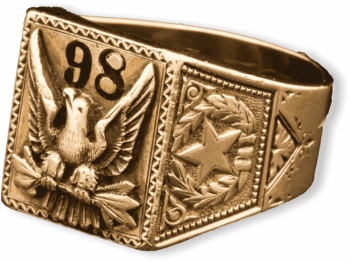
The design made for the Class of 1894 was the first known to feature an eagle on the top, state seal on one side and crossed saber and rifle on the other; there is an 1898 example in The Association’s display collections.
The Ring Committee appointed in 1933 – made up of students, former students and faculty, and led by the head of The Association of Former Students – added the words “Texas A&M College-1876” and standardized the design and production for an Aggie Ring that is visibly similar to those worn ever since.
That recognizability paid off. Leopold said, “Younger Ags saw how powerful the ring was in connecting with older Ags. I saw Aggie Rings as I traveled around the world, and it proved to be an immediate way to reach out and connect.”
Read the full story on the Association of Former Students website.


